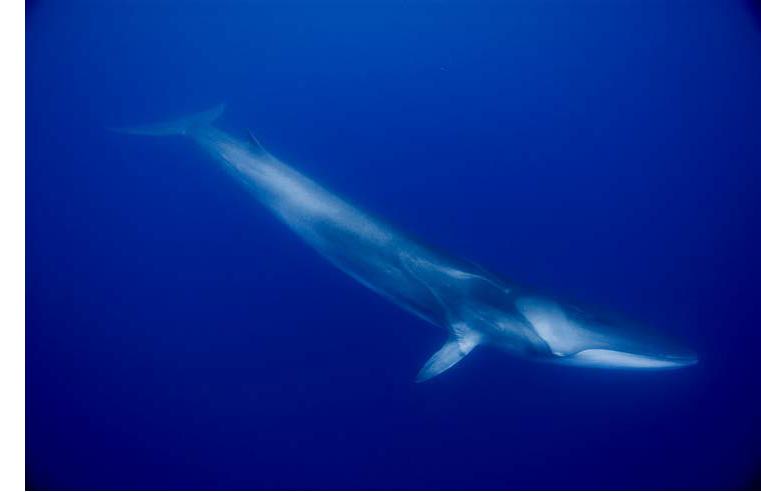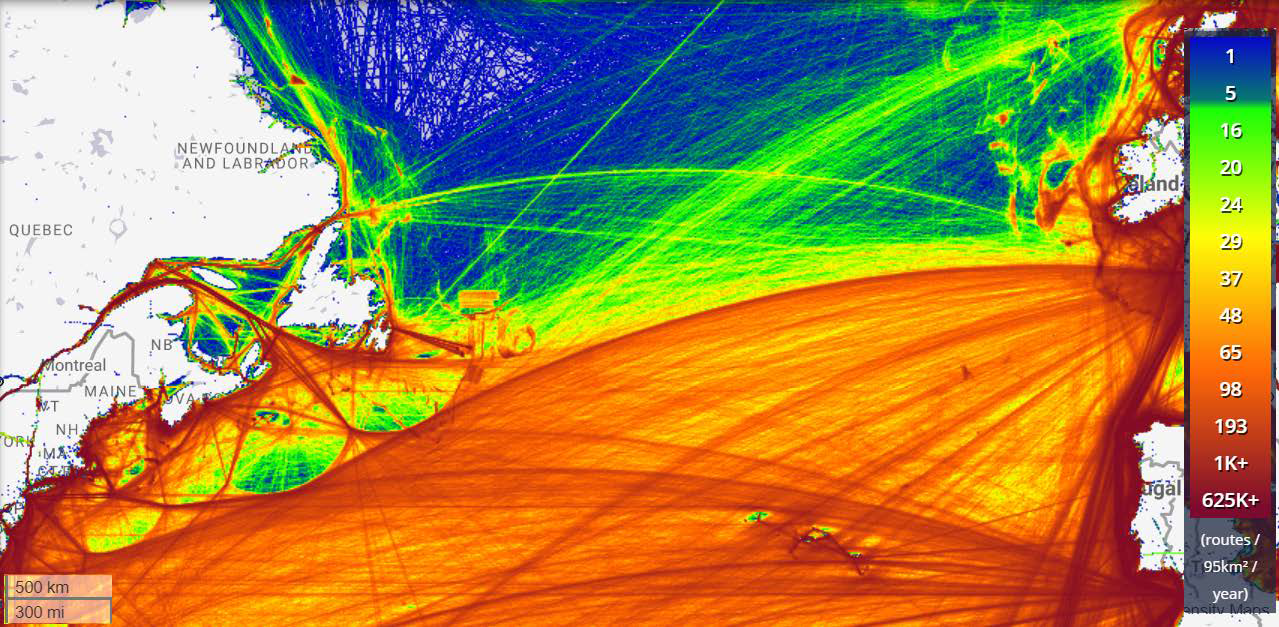Noise pollution and ship traffic threaten Atlantic whales
Printable version (PDF - 321 kB)
ST. JOHN'S, NEWFOUNDLAND (May 6, 2019). Canada’s marine protected areas are more important than ever. The Committee on the Status of Endangered Wildlife in Canada (COSEWIC) has just assessed three whales, including two of the world's largest, as under threat in Canadian waters.
Fast-swimming Sei Whales are global citizens who swim thousands of kilometers to find the best places to mate, give birth, and feed. The continuing low numbers in the aftermath of whaling led COSEWIC to determine the status of Sei Whale as Endangered.
"Commercial hunting for Sei Whales only ceased in the 1970s, less than a lifetime ago for these large animals," noted Hal Whitehead, a whale expert and a Co-chair of the COSEWIC Marine Mammals Specialist Subcommittee.

Fin Whales may be faster, and stay closer to shore than Sei Whales, but individuals can range from Canada to the US, and even over to Greenland. Populations in both the Atlantic and Pacific Oceans were considered at the COSEWIC meeting to be of Special Concern.
The slower, smaller, deep-water Sowerby’s Beaked Whale, found in the Atlantic, was also assessed as being of Special Concern. It is a member of a little-known family that is making the news as a result of fatal strandings.
Like the Blue Whale and the North Atlantic Right Whale, all three of the whales recently considered by COSEWIC are threatened by human activity. All get tangled in fishing gear, and all are struck and killed by the ever-increasing number of large ships. And, because all evolved in a quieter sea, the noise from ships, naval exercises, and ongoing seismic exploration impedes their communication and survival.
Sowerby’s Beaked Whale seems to be particularly susceptible to noise pollution. Much like bats, it uses sound to navigate and hunt, and human-generated noise impairs its ability to find its way. Increased noise from seismic exploration and military exercises is linked to injuries and death of other beaked whales.
Sightings of Sowerby’s Beaked Whale have increased in the Gully submarine canyon off the coast of Nova Scotia since it was made a Marine Protected Area in 2004.
"Noise levels are now likely lower in the Gully since it was protected," suggested Whitehead. "These refuges offer some hope for all these species and should be expanded, even into international waters."

Indeed, the future of wide-ranging species like whales relies on decisions and practices in many countries. Shared responsibility calls for shared action. According to John Reynolds, Chair of COSEWIC, "Species don't care about borders. We need to address threats as a global community. No country can save these species on its own."
Further details on all wildlife species assessed at this meeting can be found on the COSEWIC website.
Next meeting
COSEWIC’s next scheduled wildlife species assessment meeting will be held in November 2019.
About COSEWIC
COSEWIC assesses the status of wild species, subspecies, varieties, or other important units of biological diversity, considered to be at risk in Canada. To do so, COSEWIC uses scientific, Aboriginal traditional and community knowledge provided by experts from governments, academia and other organizations. Summaries of assessments are currently available to the public on the COSEWIC website and will be submitted to the Federal Minister of the Environment and Climate Change in fall 2019 for listing consideration under the Species at Risk Act (SARA). At that time, the status reports and status appraisal summaries will be publicly available on the Species at Risk Public Registry.
At its most recent meeting, COSEWIC assessed 20 wildlife species in various COSEWIC risk categories, including 9 Endangered, 3 Threatened, and 4 Special Concern. In addition, COSEWIC assessed 4 additional wildlife species as Extirpated from Canada.
COSEWIC comprises members from each provincial and territorial government wildlife agency, four federal entities (Canadian Wildlife Service, Parks Canada Agency, Fisheries and Oceans Canada, and the Canadian Museum of Nature), three Non-government Science Members, and the Co-chairs of the Species Specialist and the Aboriginal Traditional Knowledge Subcommittees.
Definition of COSEWIC terms and status categories:
Wildlife Species: A species, subspecies, variety, or geographically or genetically distinct population of animal, plant or other organism, other than a bacterium or virus, that is wild by nature and is either native to Canada or has extended its range into Canada without human intervention and has been present in Canada for at least 50 years.
Extinct (X): A wildlife species that no longer exists.
Extirpated (XT): A wildlife species that no longer exists in the wild in Canada, but exists elsewhere.
Endangered (E): A wildlife species facing imminent extirpation or extinction.
Threatened (T): A wildlife species that is likely to become Endangered if nothing is done to reverse the factors leading to its extirpation or extinction.
Special Concern (SC): A wildlife species that may become Threatened or Endangered because of a combination of biological characteristics and identified threats.
Not at Risk (NAR): A wildlife species that has been evaluated and found to be not at risk of extinction given the current circumstances.
Data Deficient (DD): A category that applies when the available information is insufficient (a) to resolve a wildlife species’ eligibility for assessment or (b) to permit an assessment of the wildlife species’ risk of extinction.
Species at Risk: A wildlife species that has been assessed as Extirpated, Endangered, Threatened or Special Concern.
| Dr. John Reynolds Chair, COSEWIC Department of Biological Sciences Simon Fraser University Telephone: 778-782-5636 |
For general inquiries: COSEWIC Secretariat Canadian Wildlife Service Environment and Climate Change Canada 351 St. Joseph Blvd, 16th floor Gatineau QC K1A 0H3 Telephone: 819-938-4125 Fax: 819-938-3984 Cosewic |
| For inquiries on arthropods (Frosted Elfin, Karner Blue): Dr. David McCorquodale Cape Breton University Telephone: 902-574-1547 |
For inquiries on birds (Hudsonian Godwit): Dr. Marcel Gahbauer Canadian Wildlife Service |
| For inquiries on freshwater fishes (Gravel Chub, Paddlefish): Dr. Nicholas E. Mandrak University of Toronto (Scarborough) Telephone: 416-208-2248 |
For inquiries on lichens (Cryptic Paw Lichen, White-rimmed Shingle Lichen): Dr. David H. S. Richardson Saint Mary's University Telephone: 902-496-8174 |
| For inquiries on marine fishes (Shortfin Mako (Atlantic population)): Dr. John D. Neilson Telephone: 250 465-1728 |
For inquiries on marine mammals (Fin Whale, Sei Whale (Atlantic population), Sowerby's Beaked Whale): Dr. Hal Whitehead Dalhousie University Telephone: 902-494-3723 Telephone: 902-414-6140 |
| For inquiries on mosses (Carey's Small Limestone Moss, Dalton's Moss, Drooping-leaved Beard-moss): Dr. René Belland University of Alberta Telephone: 780-492-0801 |
For inquiries on terrestrial mammals (Vancouver Island Marmot): Dr. Chris Johnson University of Northern BC Telephone: 250-960-5357 |
| For inquiries on plants (Dwarf Hesperochiron, Goldenseal, Hairy Paintbrush, Columbian Quillwort): Dr. Jana Vamosi University of Calgary Telephone: 403-210-9594 |
For inquiries on Aboriginal Traditional Knowledge: Roger Gallant Telephone: 709-638-4343 |

